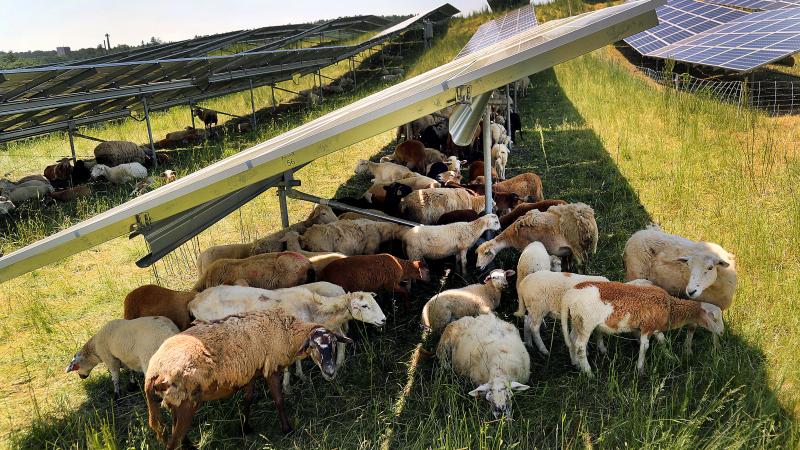Endangered listing of a sagebrush lizard exposes double standard between oil and wind energy
Wind power gets a free pass, but oil and gas? Not so much: Dr. Shawn Smallwood, an experienced ecologist says that the number of eagles and other birds killed by wind turbines is being under-counted and are being ignored.
The federal government recently listed an obscure lizard as an endangered species under the Endangered Species Act. The lizard’s habitat is in the Permian Basin, the nation’s most prolific oil and gas region, and the listing could restrict operations there. The reaction to the impacts on the lizard stand in stark contrast to how the federal government reacts when wildlife is impacted by wind energy.
Dr. Shawn Smallwood is an ecologist who has been working as a consultant for a wide range of clients, including wind energy companies, for 25 years.
In the course of his work, he’s raised concerns that the renewable industry is undercounting the number of birds killed by wind turbines. As a result of his refusal to back down on the concerns, he said, the industry has shunned him.
“The industry pretty much hates me, and I don’t really have a forum to address them anymore,” Smallwood told Just the News.
Smallwood said that the most dishonest opposition he’s experienced comes from the government permitting agencies, who are often the most resistant to cooperating with mitigation efforts.
It’s a similar story for researchers and activists concerned about the impacts of offshore wind on whales.
Robert Rand, founder of the acoustics consultancy company Rand Acoustics, has been trying to draw attention to what his research is showing, which is that there is a lack of adequate protections for the whales that migrate along this corridor where offshore wind projects are being developed.
He’s produced a couple of studies, which found that mitigation efforts being implemented to protect whales are inadequate. He told Just the News in April that he’s submitted both studies to the federal agencies that permit the projects and received little in the way of a response.
The offshore wind industry has mostly received a free pass when it comes to its impacts on marine animals despite mounting evidence that it’s causing a recent uptick in the deaths of endangered whales. The official position of the federal government is that it’s simply not happening, despite increasing number of dead whales washing shore.
“At this point, there is no scientific evidence that noise resulting from offshore wind site characterization surveys could potentially cause whale deaths. There are no known links between large whale deaths and ongoing offshore wind activities,” the National Oceanic and Atmospheric Administration Fisheries states on its website.
Double standard
When it comes to impacts on wildlife from oil and gas projects, the response from the feds is often considerably different.
In 2023, when a new species of whale was discovered in the Gulf of Mexico, the Biden administration sought to restrict oil and gas operations in a large swath of the Gulf out of vague concerns the whales might be impacted. A federal district judge ordered lease sales to proceed in that case.
The U.S. Fish and Wildlife Service (FWS) recently handed environmentalists a major win by listing a small reptile as endangered.
“The Endangered Species Act is an important tool in preventing the extinction of imperiled species like the dunes sagebrush lizard,” Amy Lueders, the Southwest regional director for the FWS, said in a statement, which goes on to explain that the primary threats to the lizard’s existence are oil and gas development and climate change.
The Texas Railroad Commission, which oversees the oil and gas industry and associated infrastructure, said in a statement on the listing that the Biden administration made the designation despite years of public and private collaborative efforts, which have resulted in the populations of the lizard rebounding.
“This doesn’t have a thing to do with ‘saving lizards’; it’s about shutting down U.S. oil and gas production to win political brownie points, which will only increase inflation and jeopardize billions of lives globally,” said Commissioner Wayne Christian.
The commission vowed not to cooperate with the feds in enforcing the Endangered Species Act. They voted unanimously this month to request that Texas Attorney General Ken Paxton, a Republican, file a lawsuit over the decision to list the lizard as endangered, E&E News reports.
Survivorship bias
Smallwood has conducted a number of surveys of the impacts of wind turbines on bird and bat populations. He’s used thermal imaging cameras to track the animals movements, and he’s done analyses of their fatality risks around turbine blades.
He said the mortality surveys, which count the number of dead birds at a wind farm, have an inherent bias. The assumption is that if there’s no body, there’s no kill. He said he’s seen evidence of birds with injuries from blade strikes, and these injured birds, which die from their injuries away from the wind farm, don’t get counted. He said some bird’s carcasses are destroyed by the blades, leaving nothing to count, and some dead birds get carried off by scavengers.
It’s called the survivorship bias. In World War II, engineers were looking at where to reinforce armor on aircraft that managed to limp back to base by studying where the most of the bullet holes on the planes’ bodies were located. The assumption was that these were the best place to put more armor.
However, a mathematician named Abraham Wald pointed out that the planes returning to base show where the least amount of armor is needed. The planes shot down are never studied because they never return to base. With respect to birds killed by wind turbines, the assumption is the opposite, but the bias is the same.
Smallwood has also studied the effectiveness of mitigation efforts such as painting blades to make them more visible — called contrasting — as well as systems to stop the blades when birds or bats are near — called detect and curtail. He said he advocated for both approaches a couple decades ago, but California officials dismissed the idea. Now that these solutions are being tried, his research has found they don’t work well.
In the case of detect and curtail, he said, it works well for bats. For birds, many of which die from colliding with buildings and windows, they will just fly into a stationary blade.
“For birds, I would argue there's no solution yet,” Smallwood said.
While the federal government denies that the offshore wind industry is having any serious impacts on whales, it has acknowledged that the wind industry is killing birds. Rather than viewing the problem as a reason to restrict development, however, federal agencies are partnering with the industry to try to mitigate the impacts while allowing development to proceed.
For the oil and gas industry, it doesn’t take much to get the federal government’s and environmentalists’ to pay attention. Even a small lizard with a rebounding population or a new whale that isn’t showing up dead on shores is a big enough concern to try to halt development.
The Facts Inside Our Reporter's Notebook
Links
- Rand Acoustics
- couple of studies
- Just the News in April
- despite mounting evidence
- states on its website
- dead whales washing shore
- new species of whale was discovered
- said in a statement
- dunes sagebrush lizard
- said in a statement
- survivorship bias
- die from colliding with buildings and windows
- wind industry is killing birds
- federal agencies are partnering with the industry














